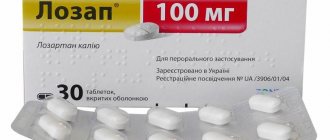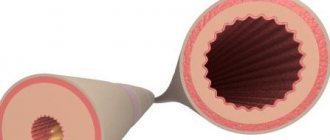Lozap
Antihypertensive drug. Specific angiotensin II receptor antagonist (AT1 subtype). Does not inhibit kininase II, an enzyme that catalyzes the conversion of angiotensin I to angiotensin II. Reduces peripheral vascular resistance, blood concentrations of adrenaline and aldosterone, blood pressure, pressure in the pulmonary circulation; reduces afterload and has a diuretic effect. Prevents the development of myocardial hypertrophy, increases exercise tolerance in patients with chronic heart failure. Losartan does not inhibit ACE kininase II and, accordingly, does not prevent the destruction of bradykinin, so side effects indirectly associated with bradykinin (for example, angioedema) occur quite rarely.
In patients with arterial hypertension without concomitant diabetes mellitus with proteinuria (more than 2 g/day), the use of the drug significantly reduces proteinuria, albumin and immunoglobulin G excretion.
Stabilizes the level of urea in blood plasma. Does not affect autonomic reflexes and does not have a long-term effect on the concentration of norepinephrine in the blood plasma. Losartan at a dose of up to 150 mg/day does not affect the levels of triglycerides, total cholesterol and HDL cholesterol in the blood serum in patients with arterial hypertension. At the same dose, losartan does not affect fasting blood glucose levels.
After a single oral dose, the hypotensive effect (systolic and diastolic blood pressure decreases) reaches a maximum after 6 hours, then gradually decreases over 24 hours.
The maximum hypotensive effect develops 3-6 weeks after starting the drug.
Pharmacokinetics
Suction
When taken orally, losartan is well absorbed and undergoes first-pass metabolism through the liver by carboxylation with the participation of the cytochrome CYP2C9 isoenzyme to form an active metabolite. Systemic bioavailability of losartan is about 33%. Cmax of losartan and its active metabolite is achieved in the blood serum approximately 1 hour and 3-4 hours after oral administration, respectively. Food intake does not affect the bioavailability of losartan.
Distribution
More than 99% of losartan and its active metabolite are bound to plasma proteins, mainly albumin. Vd of losartan - 34 l. Losartan practically does not penetrate the BBB.
Metabolism
Approximately 14% of losartan administered to a patient intravenously or taken orally is converted into an active metabolite.
Removal
Plasma clearance of losartan is 600 ml/min, and the active metabolite is 50 ml/min. The renal clearance of losartan and its active metabolite is 74 ml/min and 26 ml/min, respectively. When taken orally, approximately 4% of the dose taken is excreted unchanged by the kidneys and about 6% is excreted by the kidneys in the form of an active metabolite. Losartan and its active metabolite exhibit linear pharmacokinetics when administered orally in doses up to 200 mg.
After oral administration, plasma concentrations of losartan and its active metabolite decrease polyexponentially with a final T1/2 of losartan of about 2 hours, and of the active metabolite - about 6-9 hours. When taking the drug at a dose of 100 mg/day, neither losartan nor the active metabolite accumulate significantly in blood plasma. Losartan and its metabolites are excreted from the body through the intestines and kidneys. In healthy volunteers, after oral administration of 14C-labeled losartan, about 35% of the radioactive label is found in the urine and 58% in the feces.
Pharmacokinetics in special clinical situations
In patients with mild to moderate alcoholic cirrhosis, the concentration of losartan was 5 times higher, and the active metabolite was 1.7 times higher than in healthy male volunteers.
When CC >10 ml/min, the concentration of losartan in the blood plasma does not differ from that with normal renal function. In patients who require hemodialysis, the AUC is approximately 2 times higher than in patients with normal renal function.
Neither losartan nor its active metabolite is removed from the body by hemodialysis.
Plasma concentrations of losartan and its active metabolite in elderly men with arterial hypertension do not differ significantly from the values of these parameters in young men with arterial hypertension.
Plasma concentrations of losartan in women with arterial hypertension are 2 times higher than the corresponding values in men with arterial hypertension. Concentrations of the active metabolite do not differ between men and women. This pharmacokinetic difference is not clinically significant.
Release form and composition
Lozap is available in the form of white or almost white, oblong biconvex film-coated tablets (10 pieces in blisters, 3, 6 or 9 blisters in a cardboard pack).
The active ingredient is losartan potassium (12.5 mg, 50 mg or 100 mg in 1 tablet).
Auxiliary components: mannitol, talc, microcrystalline cellulose, colloidal anhydrous silicon dioxide, magnesium stearate, crospovidone.
Film shell composition: macrogol 6000 and sepifilm 752 white (macrogol 2000 stearate, microcrystalline cellulose, hypromellose, titanium dioxide).
Side effects
Side effects of the drug, occurring with a frequency of more than 1% and comparable to placebo:
- General reactions: pain in the chest, fatigue, asthenia, peripheral edema;
- From the digestive system: nausea, diarrhea, dyspeptic symptoms, abdominal pain;
- From the cardiovascular system: tachycardia, palpitations;
- From the central nervous system: headache, dizziness, insomnia;
- From the musculoskeletal system: cramps of the calf muscles, pain in the legs and back;
- From the respiratory system: sinusitis, pharyngitis, nasal congestion, bronchitis, cough, upper respiratory tract infections.
Side effects of the drug Lozap, occurring with a frequency of less than 1%:
- From the digestive system: dryness of the oral mucosa, vomiting, anorexia, gastritis, toothache, liver dysfunction, hepatitis, constipation, flatulence; very rarely - hyperbilirubinemia, moderate increase in the activity of alanine aminotransferase and aspartate aminotransferase;
- From the cardiovascular system: nosebleeds, arrhythmias, vasculitis, dose-dependent orthostatic hypotension, angina pectoris, bradycardia, myocardial infarction;
- From the central and peripheral nervous system: drowsiness, sleep disturbance, peripheral neuropathy, anxiety, hypoesthesia, paresthesia, memory disorders, fainting, ataxia, tremor, migraine, depression;
- From the musculoskeletal system: pain in the knee, shoulder, arthritis, arthralgia, fibromyalgia;
- From the reproductive system: impotence, decreased libido;
- From the urinary system: impaired renal function, urinary tract infections, sudden urge to urinate; sometimes - an increase in the level of creatinine or urea and residual nitrogen in the blood serum;
- From the senses: impaired vision, taste, conjunctivitis, ringing in the ears;
- Metabolism: often – hyperkalemia; gout;
- From the hematopoietic system: sometimes - thrombocytopenia, anemia, Henoch-Schönlein purpura, eosinophilia;
- Allergic reactions: itching, skin rash, angioedema, urticaria;
- Dermatological reactions: ecchymosis, dry skin, photosensitivity, erythema, alopecia, increased sweating.
Side effects of Lozap are usually transient and if they occur, discontinuation of the drug is not required.
Drug overdose
An overdose of Lozap is manifested by the following warning symptoms:
- Slow heartbeat;
- Heart rhythm disturbances;
- A sharp decrease in blood pressure up to a hypotensive crisis.
Treatment involves diuresis and taking medications, the action of which is aimed at eliminating the symptoms of overdose.
Overdose can cause a sharp drop in blood pressure
Which is better Amzaar or Lortenza
Any drug has its pros and cons, but if we think from the point of view of a simple buyer, the following observations arise. The main elements that make up Lortenza are similar to the Korean medicine. In addition, the indications for use for both drugs are the same. Instructions for use may vary.
There are just a few reviews about Lortense. Most likely this is due to the fact that the product is not as widespread as its Korean counterpart. Buyers say that Lortenza keeps blood pressure normal. But basically, a lot depends on the individual’s tolerance to the drug.
Amzaar (instructions included) is more expensive than Lortenza. But is it really worth saving on your health? The main thing is the result that we get for our money. Moreover, the product has proven itself well both in the pharmaceutical market and among buyers. And you need to trust only well-tested products. So, which is better - Amzaar or Lortenza? The answer to this question is quite obvious - Amzaar.
special instructions
Before treatment, it is necessary to correct dehydration or begin drug therapy with a lower dose.
If there is a history of liver disease, Lozap is prescribed in lower doses.
During treatment, potassium levels in the blood should be regularly monitored, especially in patients with impaired renal function and in the elderly.
The drug does not affect the ability to drive vehicles or operate other potentially dangerous mechanisms.
Instructions for use 5 50, 5 100 mg
Before starting treatment with Amzaar tablets, carefully read the instructions for use. Under no circumstances should you experiment with dosages as you please. All factors should be taken into account, because inexperience can have the opposite effect.
How to use?
The medicine Amzaar is taken directly orally once a day with water. This is done regardless of food intake.
Dosage
It is best to start treatment after preliminary selection of the required dosages of amplodipine and losartan. The general condition of the patient often changes, in which case it is necessary to change the dose of one of the active elements in the combination drug. The doctor selects doses of different components individually for each patient.
People who take amlodipine and losartan together are switched to a combination medicine containing both substances in similar doses.
Patients are recommended to take one tablet per day, as described above. The minimum initial dosage, according to the instructions for use, is Amzaar 5/50 mg. If such a dosage does not produce the desired effect, then the doctor may prescribe Amzaar 5/100. Sometimes, to achieve certain blood pressure levels, it is necessary to increase the dosage.
special instructions
During treatment, patients with reduced circulating blood volume may encounter problems such as the development of arterial hypotension.
In older people, there is no need to adjust the dose of Amzaar, but it should be increased carefully. Children and adolescents under eighteen years of age should avoid using Amzaar, since it is unknown how it will affect a fragile body
Children and adolescents under eighteen years of age should avoid using Amzaar, since it is unknown how it will affect a fragile body.
Pregnant and lactating women should refrain from using Amzaar 5/50, as described in the instructions.
Drivers taking Amzaar 5/100 (instructions for use should be reviewed carefully) should be especially careful when driving a car or other vehicle: they may suddenly become dizzy. Regardless of the dosage of the drug, there are certain risks
If there is an individual intolerance to certain components of Amzaar, then treatment should be abandoned. This also applies to the occurrence of an unexpected state of shock in a person. People suffering from diabetes can be safely treated with Korean Amzaar tablets, following the instructions for use.
Use with other drugs
Before treatment, you must inform your doctor about taking all medications. Their interaction with Amzaar may provoke unwanted reactions and complications. The instructions recommend considering the following points:
- Simultaneous use with other drugs for high blood pressure enhances the hypotensive effect of Amzaar.
- Erythromycin, Diltiazem, Itraconazole, Ritonavir and other CYP3A4 inhibitors increase the concentration of amlodipine in the blood.
- When taken simultaneously with St. John's wort, Rifampicin and other CYP3A4 inducers, unpredictable pressure surges are possible. For this reason, blood pressure must be constantly monitored.
- Combination with lithium drugs can cause nausea, tinnitus, tremor, diarrhea, and ataxia.
- The simultaneous use of amlodipine with beta-blockers may provoke an exacerbation of heart failure.
- Combination with Quinidine, Amiodarone and other slow calcium channel blockers enhances the reduction in heart rate.
- Neuroleptics and isoflurane enhance the effect of amlodipine.
- Intravenous administration of Dotrolene during the use of Amzaar can provoke arrhythmia, collapse, decreased strength of heart contractions, and hyperkalemia.
- Calcium supplements can reduce the effect of amlodipine.
Nonsteroidal anti-inflammatory drugs reduce the effect of losartan. The combination of the drug with ACE inhibitors and angiotensin receptor antagonists can cause complications on the kidneys, so it is necessary to constantly monitor their condition. Fluconazole, an inhibitor of the CYP2C9 isoenzyme, increases the level of losartan in the blood, while Rifampin decreases it.
Contraindications
Lozap is not used in patients under the age of 18 (since the safety and effectiveness of the drug have not been established), pregnant and lactating women and persons with increased individual sensitivity to the components.
The drug is prescribed with caution when there is a decrease in circulating blood volume, arterial hypotension, renal and/or liver failure, stenosis of the artery of a single kidney or bilateral stenosis of the renal arteries, disturbances in water and electrolyte balance.




